BBM203/05 Business Statistics: Probability and Statistical Analysis
VerifiedAdded on 2023/06/11
|8
|1669
|207
Homework Assignment
AI Summary
This assignment focuses on probability distributions and statistical analysis within the context of Business Statistics (BBM203/05). It includes problems related to calculating probabilities from card selections, analyzing student travel data using contingency tables, and applying Poisson distribution to model machine breakdowns. The solutions demonstrate the application of probability rules, conditional probability, and statistical inference. The assignment covers topics such as calculating probabilities with and without replacement, determining independence of events, and using the Poisson distribution to model rare events. Desklib offers this solution and many more to aid students in their studies.
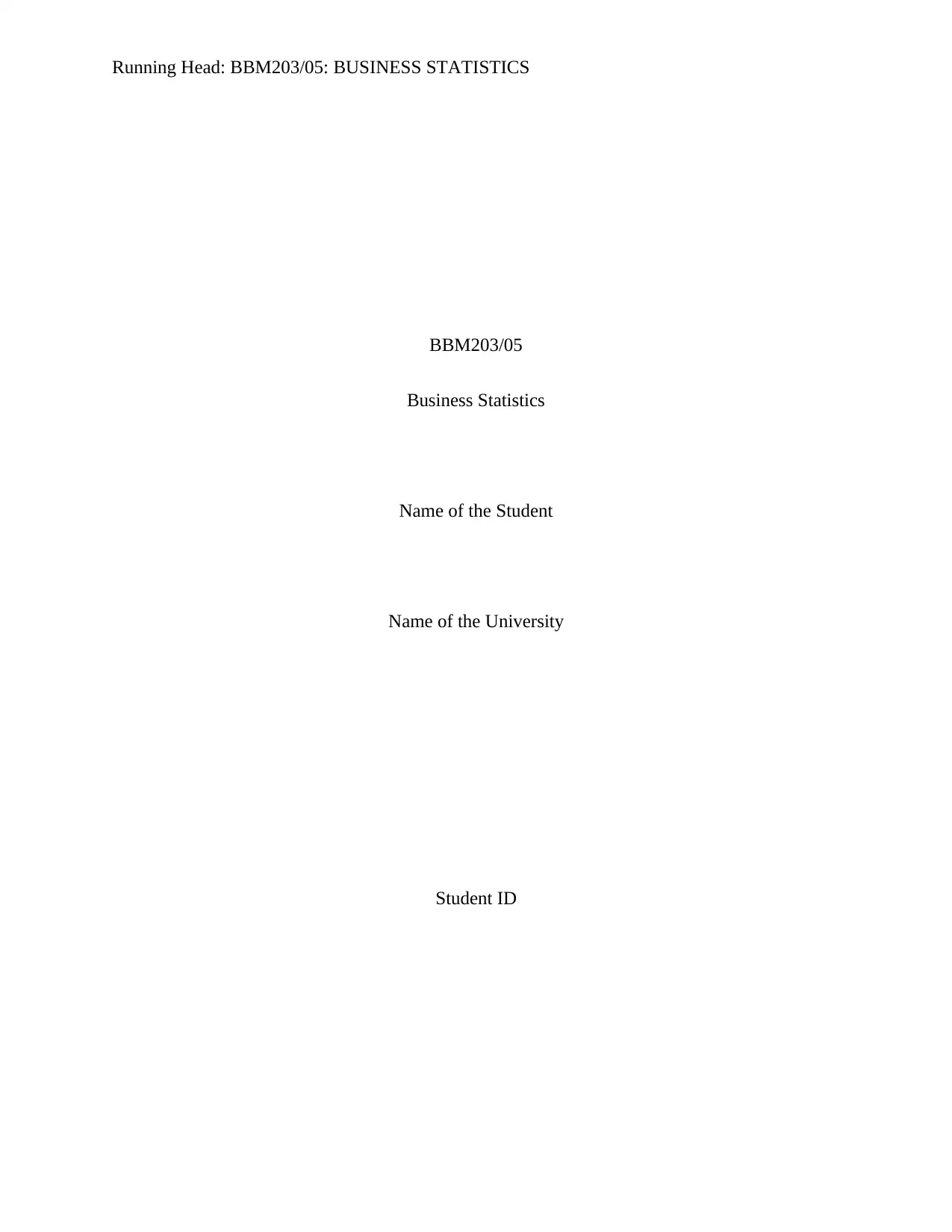
Running Head: BBM203/05: BUSINESS STATISTICS
BBM203/05
Business Statistics
Name of the Student
Name of the University
Student ID
BBM203/05
Business Statistics
Name of the Student
Name of the University
Student ID
Paraphrase This Document
Need a fresh take? Get an instant paraphrase of this document with our AI Paraphraser

1BBM203/05: BUSINESS STATISTICS
Answer 1
(a) Total number of cards = 8
Number of Purple cards = 1
Number of Green cards = 2
Number of Orange cards = 2
Number of Blue cards = 3
Number of Red cards = 0
(i) The probability that a card chosen at random is a purple card = P ( P )= 1
8 =0.125 .
(ii) The probability that a card chosen at random is a blue card = P ( B )= 3
8 =0.375
(iii) The probability that a card chosen at random is an orange or green card =
P ( O )+ P ( G ) =2
8 + 2
8 = 4
8 =0.5
(iv) The probability that a card chosen at random is a purple or blue card =
P ( P )+ P ( B )= 1
8 + 3
8 = 4
8 =0.5
(v) The probability that a card chosen at random is not a blue card =
1−P ( B )=1−0.375=0.625
(vi) The probability that a card chosen at random is a red card = P ( R )= 0
8 =0
(b) Two cards are chosen at random with replacement.
(i) Probability that both the cards are Orange =
( 2
2 )
( 8
2 ) = 1
28 =0.036
Answer 1
(a) Total number of cards = 8
Number of Purple cards = 1
Number of Green cards = 2
Number of Orange cards = 2
Number of Blue cards = 3
Number of Red cards = 0
(i) The probability that a card chosen at random is a purple card = P ( P )= 1
8 =0.125 .
(ii) The probability that a card chosen at random is a blue card = P ( B )= 3
8 =0.375
(iii) The probability that a card chosen at random is an orange or green card =
P ( O )+ P ( G ) =2
8 + 2
8 = 4
8 =0.5
(iv) The probability that a card chosen at random is a purple or blue card =
P ( P )+ P ( B )= 1
8 + 3
8 = 4
8 =0.5
(v) The probability that a card chosen at random is not a blue card =
1−P ( B )=1−0.375=0.625
(vi) The probability that a card chosen at random is a red card = P ( R )= 0
8 =0
(b) Two cards are chosen at random with replacement.
(i) Probability that both the cards are Orange =
( 2
2 )
( 8
2 ) = 1
28 =0.036
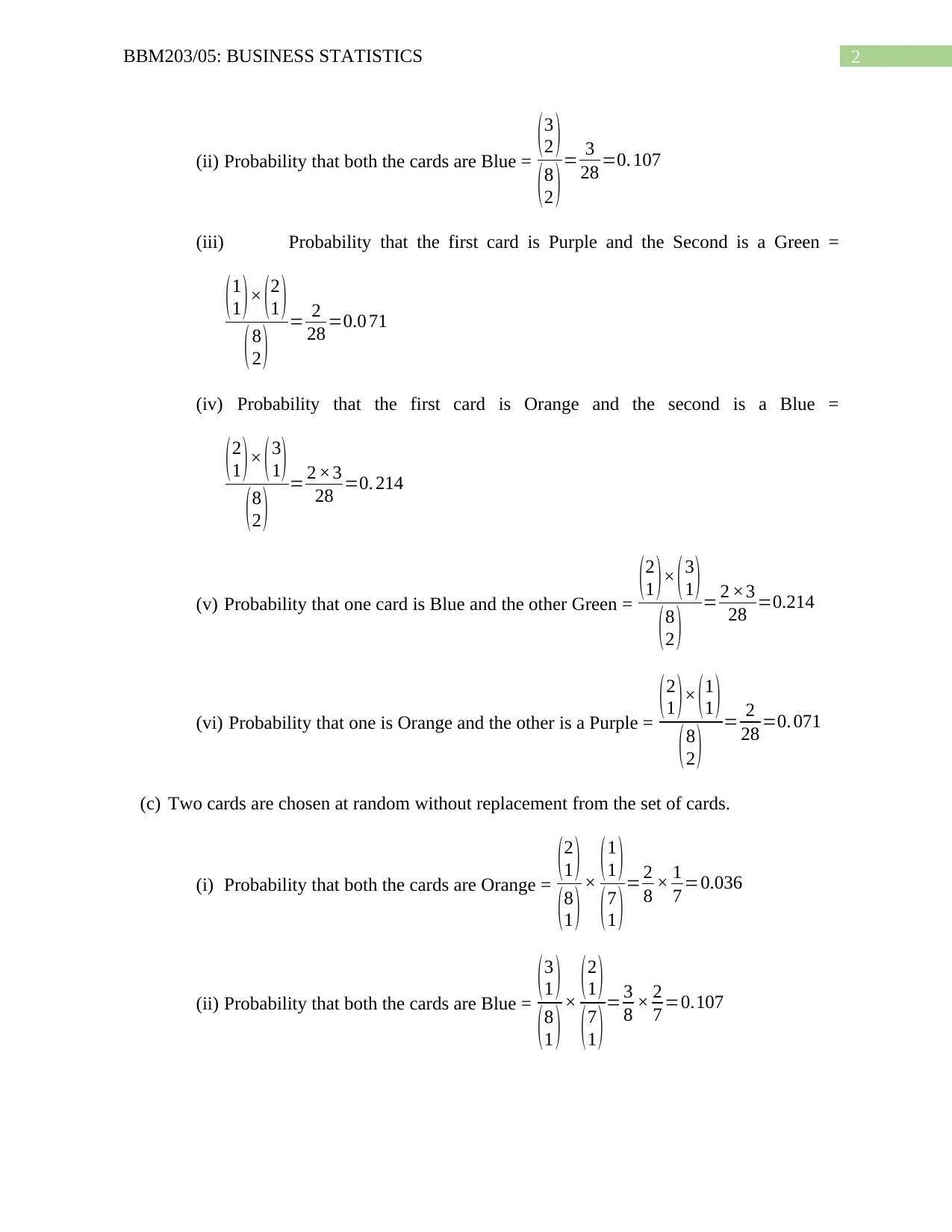
2BBM203/05: BUSINESS STATISTICS
(ii) Probability that both the cards are Blue =
( 3
2 )
( 8
2 ) = 3
28 =0. 107
(iii) Probability that the first card is Purple and the Second is a Green =
( 1
1 ) × ( 2
1 )
( 8
2 ) = 2
28 =0.0 71
(iv) Probability that the first card is Orange and the second is a Blue =
( 2
1 ) × ( 3
1)
( 8
2 ) = 2 ×3
28 =0. 214
(v) Probability that one card is Blue and the other Green =
(2
1 )× (3
1 )
(8
2 ) = 2 ×3
28 =0.214
(vi) Probability that one is Orange and the other is a Purple =
( 2
1 ) × ( 1
1 )
( 8
2 ) = 2
28 =0. 071
(c) Two cards are chosen at random without replacement from the set of cards.
(i) Probability that both the cards are Orange =
(2
1 )
(8
1 ) × (1
1 )
(7
1 )= 2
8 × 1
7 =0.036
(ii) Probability that both the cards are Blue =
( 3
1 )
( 8
1 ) × ( 2
1 )
( 7
1 ) = 3
8 × 2
7 =0.107
(ii) Probability that both the cards are Blue =
( 3
2 )
( 8
2 ) = 3
28 =0. 107
(iii) Probability that the first card is Purple and the Second is a Green =
( 1
1 ) × ( 2
1 )
( 8
2 ) = 2
28 =0.0 71
(iv) Probability that the first card is Orange and the second is a Blue =
( 2
1 ) × ( 3
1)
( 8
2 ) = 2 ×3
28 =0. 214
(v) Probability that one card is Blue and the other Green =
(2
1 )× (3
1 )
(8
2 ) = 2 ×3
28 =0.214
(vi) Probability that one is Orange and the other is a Purple =
( 2
1 ) × ( 1
1 )
( 8
2 ) = 2
28 =0. 071
(c) Two cards are chosen at random without replacement from the set of cards.
(i) Probability that both the cards are Orange =
(2
1 )
(8
1 ) × (1
1 )
(7
1 )= 2
8 × 1
7 =0.036
(ii) Probability that both the cards are Blue =
( 3
1 )
( 8
1 ) × ( 2
1 )
( 7
1 ) = 3
8 × 2
7 =0.107
⊘ This is a preview!⊘
Do you want full access?
Subscribe today to unlock all pages.

Trusted by 1+ million students worldwide
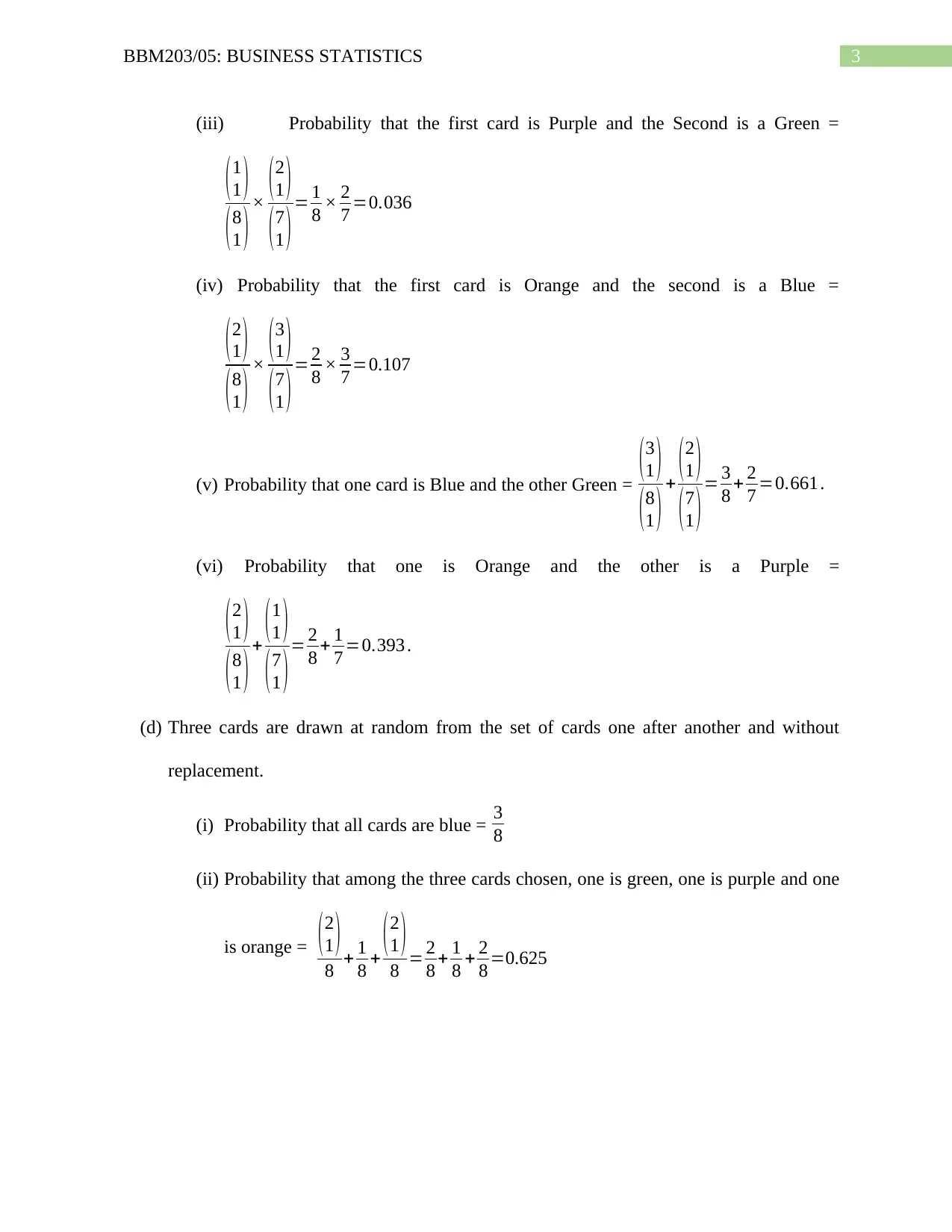
3BBM203/05: BUSINESS STATISTICS
(iii) Probability that the first card is Purple and the Second is a Green =
( 1
1 )
( 8
1 ) × ( 2
1 )
( 7
1 ) = 1
8 × 2
7 =0.036
(iv) Probability that the first card is Orange and the second is a Blue =
(2
1 )
(8
1 ) × (3
1 )
(7
1 )= 2
8 × 3
7 =0.107
(v) Probability that one card is Blue and the other Green =
( 3
1 )
( 8
1 ) + ( 2
1 )
( 7
1 ) = 3
8 + 2
7 =0.661 .
(vi) Probability that one is Orange and the other is a Purple =
( 2
1 )
( 8
1 ) + ( 1
1 )
( 7
1 ) = 2
8 + 1
7 =0.393 .
(d) Three cards are drawn at random from the set of cards one after another and without
replacement.
(i) Probability that all cards are blue = 3
8
(ii) Probability that among the three cards chosen, one is green, one is purple and one
is orange = (2
1 )
8 + 1
8 + (2
1 )
8 = 2
8 + 1
8 + 2
8 =0.625
(iii) Probability that the first card is Purple and the Second is a Green =
( 1
1 )
( 8
1 ) × ( 2
1 )
( 7
1 ) = 1
8 × 2
7 =0.036
(iv) Probability that the first card is Orange and the second is a Blue =
(2
1 )
(8
1 ) × (3
1 )
(7
1 )= 2
8 × 3
7 =0.107
(v) Probability that one card is Blue and the other Green =
( 3
1 )
( 8
1 ) + ( 2
1 )
( 7
1 ) = 3
8 + 2
7 =0.661 .
(vi) Probability that one is Orange and the other is a Purple =
( 2
1 )
( 8
1 ) + ( 1
1 )
( 7
1 ) = 2
8 + 1
7 =0.393 .
(d) Three cards are drawn at random from the set of cards one after another and without
replacement.
(i) Probability that all cards are blue = 3
8
(ii) Probability that among the three cards chosen, one is green, one is purple and one
is orange = (2
1 )
8 + 1
8 + (2
1 )
8 = 2
8 + 1
8 + 2
8 =0.625
Paraphrase This Document
Need a fresh take? Get an instant paraphrase of this document with our AI Paraphraser
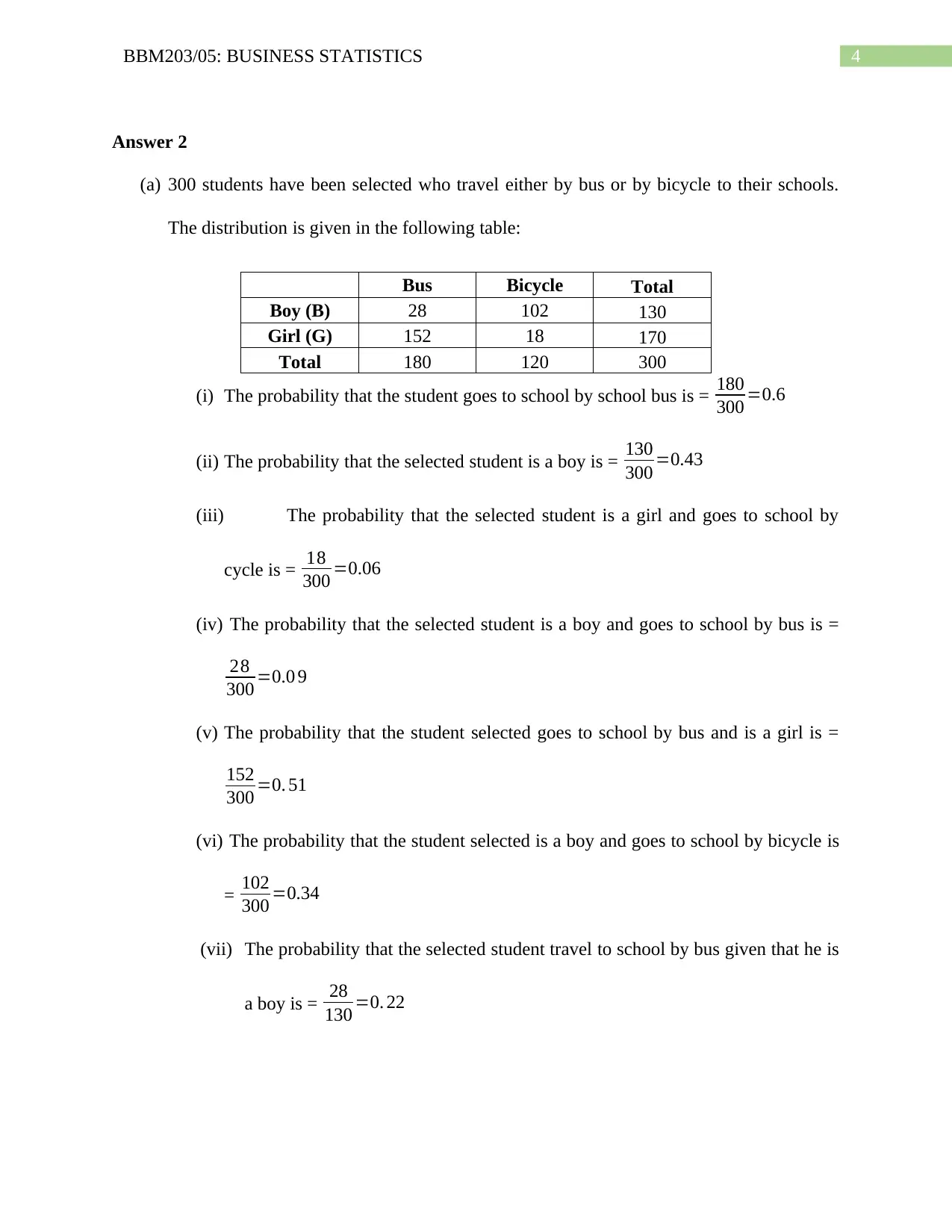
4BBM203/05: BUSINESS STATISTICS
Answer 2
(a) 300 students have been selected who travel either by bus or by bicycle to their schools.
The distribution is given in the following table:
Bus Bicycle Total
Boy (B) 28 102 130
Girl (G) 152 18 170
Total 180 120 300
(i) The probability that the student goes to school by school bus is = 180
300 =0.6
(ii) The probability that the selected student is a boy is = 130
300 =0.43
(iii) The probability that the selected student is a girl and goes to school by
cycle is = 18
300 =0.06
(iv) The probability that the selected student is a boy and goes to school by bus is =
28
300 =0.0 9
(v) The probability that the student selected goes to school by bus and is a girl is =
152
300 =0. 51
(vi) The probability that the student selected is a boy and goes to school by bicycle is
= 102
300 =0.34
(vii) The probability that the selected student travel to school by bus given that he is
a boy is = 28
130 =0. 22
Answer 2
(a) 300 students have been selected who travel either by bus or by bicycle to their schools.
The distribution is given in the following table:
Bus Bicycle Total
Boy (B) 28 102 130
Girl (G) 152 18 170
Total 180 120 300
(i) The probability that the student goes to school by school bus is = 180
300 =0.6
(ii) The probability that the selected student is a boy is = 130
300 =0.43
(iii) The probability that the selected student is a girl and goes to school by
cycle is = 18
300 =0.06
(iv) The probability that the selected student is a boy and goes to school by bus is =
28
300 =0.0 9
(v) The probability that the student selected goes to school by bus and is a girl is =
152
300 =0. 51
(vi) The probability that the student selected is a boy and goes to school by bicycle is
= 102
300 =0.34
(vii) The probability that the selected student travel to school by bus given that he is
a boy is = 28
130 =0. 22
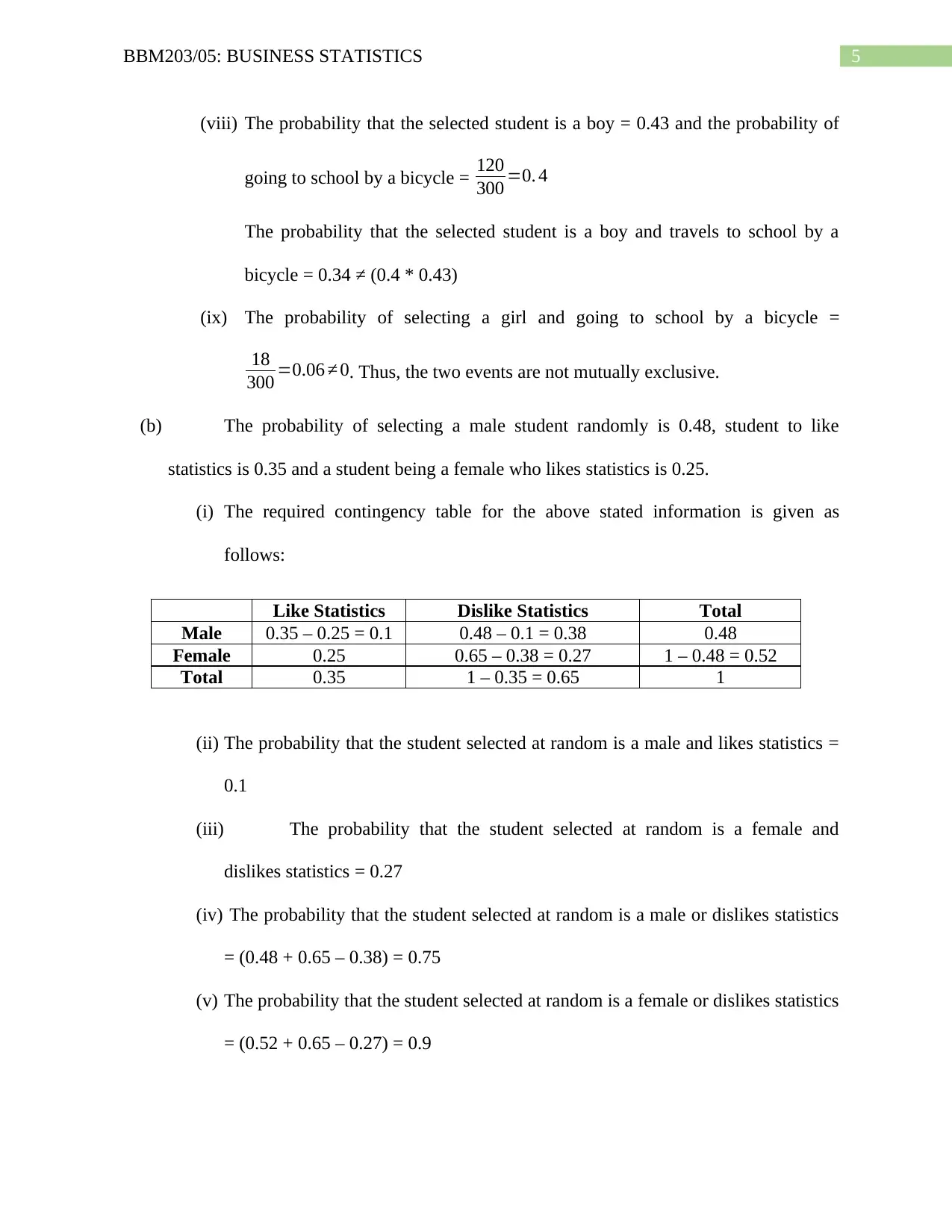
5BBM203/05: BUSINESS STATISTICS
(viii) The probability that the selected student is a boy = 0.43 and the probability of
going to school by a bicycle = 120
300 =0. 4
The probability that the selected student is a boy and travels to school by a
bicycle = 0.34 ≠ (0.4 * 0.43)
(ix) The probability of selecting a girl and going to school by a bicycle =
18
300 =0.06 ≠ 0. Thus, the two events are not mutually exclusive.
(b) The probability of selecting a male student randomly is 0.48, student to like
statistics is 0.35 and a student being a female who likes statistics is 0.25.
(i) The required contingency table for the above stated information is given as
follows:
Like Statistics Dislike Statistics Total
Male 0.35 – 0.25 = 0.1 0.48 – 0.1 = 0.38 0.48
Female 0.25 0.65 – 0.38 = 0.27 1 – 0.48 = 0.52
Total 0.35 1 – 0.35 = 0.65 1
(ii) The probability that the student selected at random is a male and likes statistics =
0.1
(iii) The probability that the student selected at random is a female and
dislikes statistics = 0.27
(iv) The probability that the student selected at random is a male or dislikes statistics
= (0.48 + 0.65 – 0.38) = 0.75
(v) The probability that the student selected at random is a female or dislikes statistics
= (0.52 + 0.65 – 0.27) = 0.9
(viii) The probability that the selected student is a boy = 0.43 and the probability of
going to school by a bicycle = 120
300 =0. 4
The probability that the selected student is a boy and travels to school by a
bicycle = 0.34 ≠ (0.4 * 0.43)
(ix) The probability of selecting a girl and going to school by a bicycle =
18
300 =0.06 ≠ 0. Thus, the two events are not mutually exclusive.
(b) The probability of selecting a male student randomly is 0.48, student to like
statistics is 0.35 and a student being a female who likes statistics is 0.25.
(i) The required contingency table for the above stated information is given as
follows:
Like Statistics Dislike Statistics Total
Male 0.35 – 0.25 = 0.1 0.48 – 0.1 = 0.38 0.48
Female 0.25 0.65 – 0.38 = 0.27 1 – 0.48 = 0.52
Total 0.35 1 – 0.35 = 0.65 1
(ii) The probability that the student selected at random is a male and likes statistics =
0.1
(iii) The probability that the student selected at random is a female and
dislikes statistics = 0.27
(iv) The probability that the student selected at random is a male or dislikes statistics
= (0.48 + 0.65 – 0.38) = 0.75
(v) The probability that the student selected at random is a female or dislikes statistics
= (0.52 + 0.65 – 0.27) = 0.9
⊘ This is a preview!⊘
Do you want full access?
Subscribe today to unlock all pages.

Trusted by 1+ million students worldwide
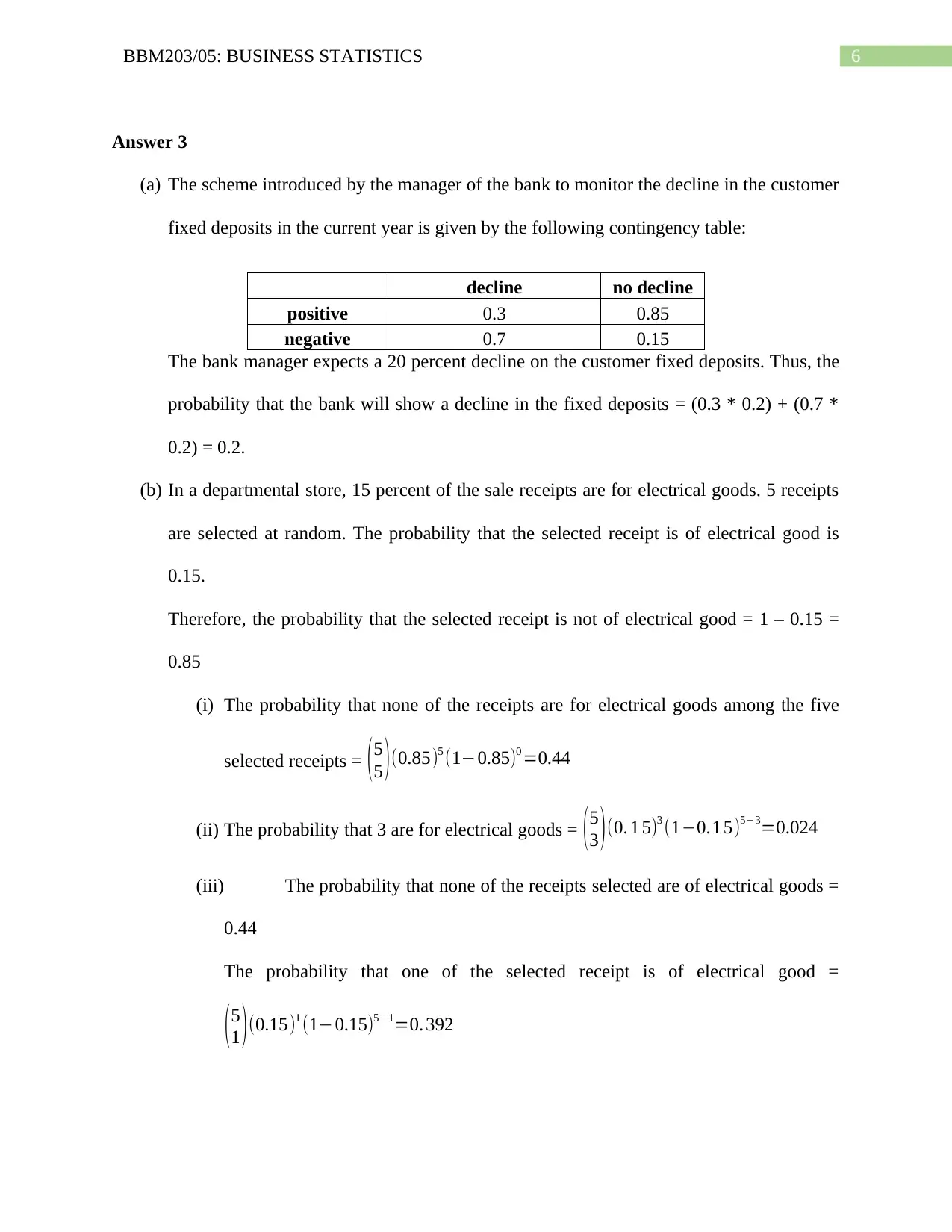
6BBM203/05: BUSINESS STATISTICS
Answer 3
(a) The scheme introduced by the manager of the bank to monitor the decline in the customer
fixed deposits in the current year is given by the following contingency table:
decline no decline
positive 0.3 0.85
negative 0.7 0.15
The bank manager expects a 20 percent decline on the customer fixed deposits. Thus, the
probability that the bank will show a decline in the fixed deposits = (0.3 * 0.2) + (0.7 *
0.2) = 0.2.
(b) In a departmental store, 15 percent of the sale receipts are for electrical goods. 5 receipts
are selected at random. The probability that the selected receipt is of electrical good is
0.15.
Therefore, the probability that the selected receipt is not of electrical good = 1 – 0.15 =
0.85
(i) The probability that none of the receipts are for electrical goods among the five
selected receipts = (5
5 )(0.85)5 (1−0.85)0 =0.44
(ii) The probability that 3 are for electrical goods = ( 5
3 ) (0. 1 5)3 (1−0.1 5)5−3=0.024
(iii) The probability that none of the receipts selected are of electrical goods =
0.44
The probability that one of the selected receipt is of electrical good =
(5
1 )(0.15)1 (1−0.15)5−1=0. 392
Answer 3
(a) The scheme introduced by the manager of the bank to monitor the decline in the customer
fixed deposits in the current year is given by the following contingency table:
decline no decline
positive 0.3 0.85
negative 0.7 0.15
The bank manager expects a 20 percent decline on the customer fixed deposits. Thus, the
probability that the bank will show a decline in the fixed deposits = (0.3 * 0.2) + (0.7 *
0.2) = 0.2.
(b) In a departmental store, 15 percent of the sale receipts are for electrical goods. 5 receipts
are selected at random. The probability that the selected receipt is of electrical good is
0.15.
Therefore, the probability that the selected receipt is not of electrical good = 1 – 0.15 =
0.85
(i) The probability that none of the receipts are for electrical goods among the five
selected receipts = (5
5 )(0.85)5 (1−0.85)0 =0.44
(ii) The probability that 3 are for electrical goods = ( 5
3 ) (0. 1 5)3 (1−0.1 5)5−3=0.024
(iii) The probability that none of the receipts selected are of electrical goods =
0.44
The probability that one of the selected receipt is of electrical good =
(5
1 )(0.15)1 (1−0.15)5−1=0. 392
Paraphrase This Document
Need a fresh take? Get an instant paraphrase of this document with our AI Paraphraser
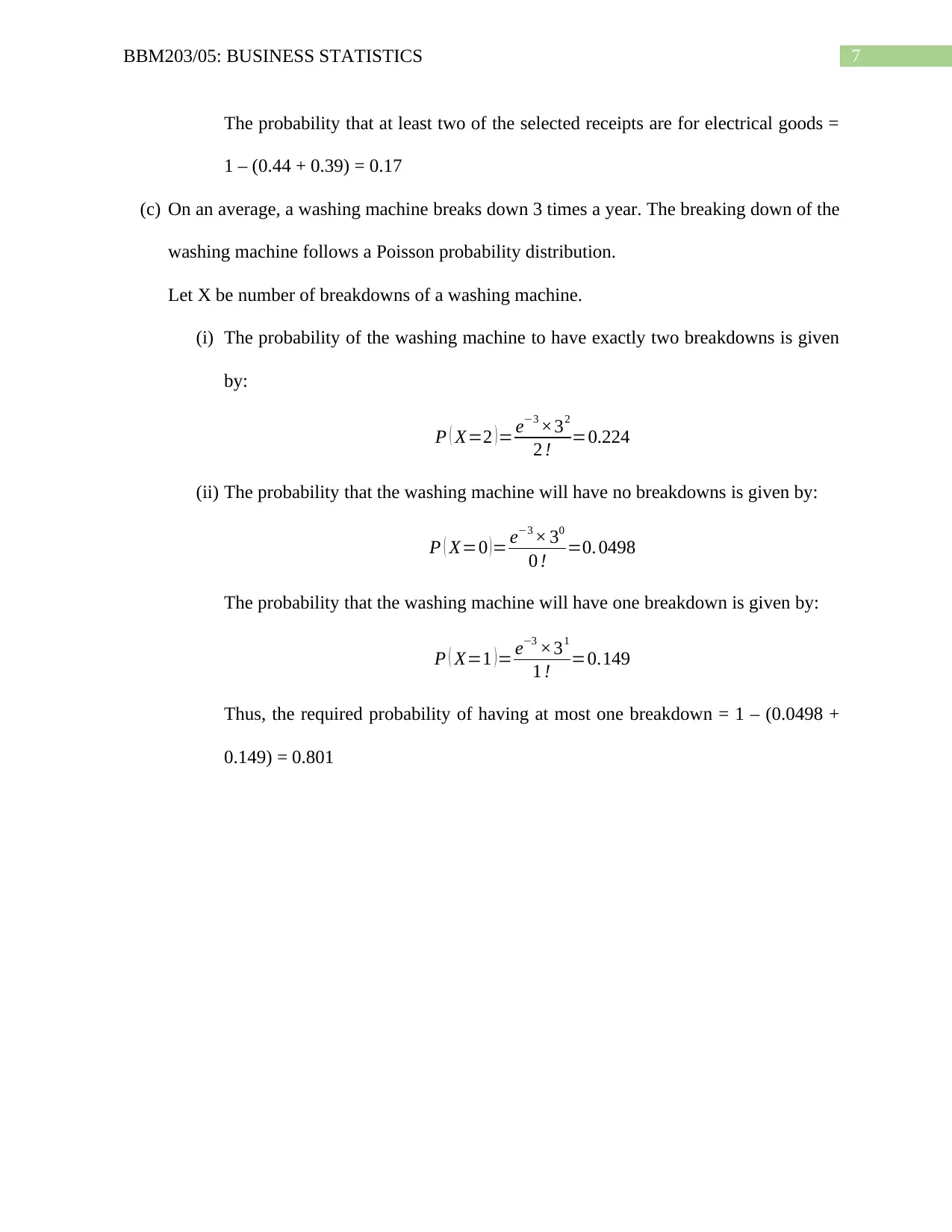
7BBM203/05: BUSINESS STATISTICS
The probability that at least two of the selected receipts are for electrical goods =
1 – (0.44 + 0.39) = 0.17
(c) On an average, a washing machine breaks down 3 times a year. The breaking down of the
washing machine follows a Poisson probability distribution.
Let X be number of breakdowns of a washing machine.
(i) The probability of the washing machine to have exactly two breakdowns is given
by:
P ( X=2 )= e−3 ×32
2 ! =0.224
(ii) The probability that the washing machine will have no breakdowns is given by:
P ( X=0 )= e−3 × 30
0 ! =0. 0498
The probability that the washing machine will have one breakdown is given by:
P ( X=1 )= e−3 ×31
1 ! =0.149
Thus, the required probability of having at most one breakdown = 1 – (0.0498 +
0.149) = 0.801
The probability that at least two of the selected receipts are for electrical goods =
1 – (0.44 + 0.39) = 0.17
(c) On an average, a washing machine breaks down 3 times a year. The breaking down of the
washing machine follows a Poisson probability distribution.
Let X be number of breakdowns of a washing machine.
(i) The probability of the washing machine to have exactly two breakdowns is given
by:
P ( X=2 )= e−3 ×32
2 ! =0.224
(ii) The probability that the washing machine will have no breakdowns is given by:
P ( X=0 )= e−3 × 30
0 ! =0. 0498
The probability that the washing machine will have one breakdown is given by:
P ( X=1 )= e−3 ×31
1 ! =0.149
Thus, the required probability of having at most one breakdown = 1 – (0.0498 +
0.149) = 0.801
1 out of 8
Related Documents
Your All-in-One AI-Powered Toolkit for Academic Success.
+13062052269
info@desklib.com
Available 24*7 on WhatsApp / Email
![[object Object]](/_next/static/media/star-bottom.7253800d.svg)
Unlock your academic potential
Copyright © 2020–2025 A2Z Services. All Rights Reserved. Developed and managed by ZUCOL.




